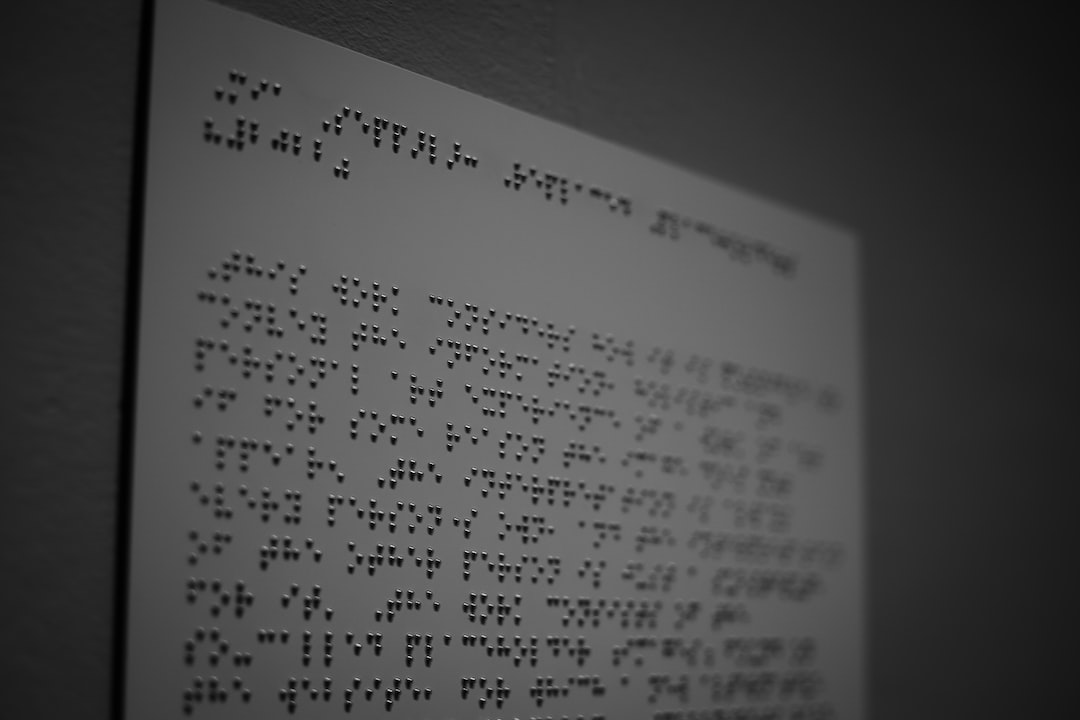Braille is a tactile writing system used by people who are blind or visually impaired to read and write. It was invented by Louis Braille in 1824 and has since become the standard means of communication for the blind.
Braille is used in a variety of settings, including in public spaces such as businesses, to ensure that people who are blind or visually impaired can access information.
If you’re a business owner, you might be curious about what the braille sign requirements are when it comes to operating your own business. Read on and we will explore whether businesses are required to provide braille signs and the reasons why they should.
The Importance of Accessibility
Accessibility is an essential aspect of modern life. It ensures that everyone, regardless of their physical abilities, can participate fully in society.
Accessible design is especially important in public spaces, where people with disabilities may need to access critical information or services. Braille signs are one example of how businesses can provide accessibility to visually impaired individuals.
The World Health Organization (WHO) estimates that approximately 2.2 billion people worldwide have a visual impairment or blindness. In the United States alone, over 25 million people have experienced vision loss to some degree. This is a sizable portion of the population that businesses should not overlook when designing signage.
Providing braille signs is an excellent way for businesses to create a more inclusive environment for people with visual impairments. By doing so, businesses can demonstrate their commitment to inclusivity and diversity.
They can promote a culture of social responsibility.
Businesses must also ensure that their workplaces are accessible to all employees, including those with disabilities.
This may involve making physical modifications, such as installing ramps or elevators or providing accessible technology. These could include tech additions such as screen readers or specialized software.
Ensuring that workplaces are accessible can improve employee satisfaction, productivity, and retention.
Legal Requirements for Braille Signs
The Americans with Disabilities Act (ADA) was enacted in 1990. It is a federal law that prohibits discrimination against people with disabilities. The ADA mandates that businesses provide equal access to goods, services, and accommodations for individuals with disabilities.
This includes providing braille signage for individuals who are blind or visually impaired.
The Americans with Disabilities Act (ADA) sets out specific requirements for braille signage in public spaces.
The ADA Standards for Accessible Design require businesses to install tactile signage with raised lettering and braille for all permanent rooms and spaces.
The regulations state that braille characters must be placed directly below the corresponding text, with a clear space of at least 3/8 inch (9.5 mm) above and below the braille.
The braille dots must be domed or rounded, and the dots must be uniformly spaced within each braille cell. These requirements help to ensure that braille signage is legible. It needs to be easily understood by visually impaired individuals.
The ADA also specifies the locations where braille signage must be installed. For example, braille signage should be placed adjacent to doorways at a height between 48 and 60 inches above the floor. Additionally, businesses must ensure that braille signs are not obstructed by any objects or other signage.
Benefits of Providing ADA-Compliant Braille Signs
Your business shouldn’t provide braille signage just because the law says that you must. It’s important to understand that providing these kinds of door and bathroom signs can benefit your own business in many ways.
Consider some of the following benefits, just the tip of the iceberg when it comes to the reasons to consider this kind of signage.
Improved Accessibility for Customers
Braille signs improve accessibility for people with visual impairments. It’s as simple as that. If you care about your customers, it’s important to take the extra step to ensure all your customers are taken care of.
These individuals may have difficulty navigating your establishment without clear signage. Providing braille signs can help these individuals locate restrooms, emergency exits, and other critical areas within your business.
Braille signs also provide an opportunity for individuals with visual impairments to navigate your establishment independently and with dignity.
Additionally, braille signs can be used in combination with audio guidance systems to provide an even more accessible experience for individuals with visual impairments.
Keeps Your Business Compliant
Providing braille signs may be required by law in some jurisdictions.
As we said, in the United States, the Americans with Disabilities Act (ADA) mandates that businesses provide accessible signage. The ADA sets out specific requirements for signage, including the use of high-contrast colors and braille.
Failure to comply with ADA requirements can result in fines, lawsuits, and damage to your business’s reputation.
Ensuring that your business provides braille signs is not only legally required but is also a demonstration of your commitment to accessibility and inclusion.
That leads us to…
Professional Image and Reputation
Providing braille signs can enhance your business’s professional image.
By demonstrating your commitment to accessibility, you can show that your business values all customers, regardless of their abilities.
This can help to build customer loyalty and attract new customers who appreciate businesses that prioritize accessibility.
Additionally, providing braille signs can improve the overall aesthetic of your establishment. Braille signs can be produced in a range of materials and finishes, including metal, plastic, and wood, and can be customized to fit your business’s branding and decor.
Highly Cost-Effective
Providing braille signs can be a cost-effective way to improve accessibility.
Braille signs are relatively inexpensive to produce and install, and they can last for many years.
By investing in braille signs, you can avoid the cost and hassle of retrofitting your establishment with more expensive accessibility features in the future.
Additionally, by providing braille signs, you can potentially avoid the cost of legal fees and fines associated with non-compliance with accessibility laws.
Live Up To Your Social Responsibility
Providing braille signs is a matter of social responsibility.
As a business owner, you have a responsibility to ensure that your establishment is accessible to all customers.
Providing braille signs can help to create a more inclusive and equitable society, where people with disabilities are valued and can participate fully in all aspects of life.
By providing braille signs, you are demonstrating your commitment to social responsibility and helping to create a more welcoming and inclusive environment for all customers.
Ensuring Proper Braille Signage
In addition to providing braille signs, it is important to ensure that the braille used is of the right type and standard.
The most commonly used type of braille is Grade 2 braille, which includes contractions and abbreviations to make reading faster and more efficient.
Grade 1 braille, which uses only the basic braille alphabet, is typically used for early learners or those who have not yet learned Grade 2 braille. It is important to use the appropriate grade of braille based on the needs of your customers.
Additionally, braille signs should be produced to a standard size and height. We mentioned these before, they are outlined in official accessibility guidelines.
The braille dots themselves should be uniform in size and spacing and should be raised above the surface of the sign to ensure they can be easily read by touch.
It is also important to ensure that the braille is positioned correctly on the sign, as positioning can greatly affect the readability of the braille.
The braille should be located directly below the corresponding text, with a space of no more than 1/8 inch between the text and the braille.
By doing the above, you can ensure that your braille signs are easily readable and accessible to all customers with visual impairments.
Where are Braille Signs Needed?
In general, any room or area within a building that is open to the public or employees should have appropriate signage. That includes braille signs where required.
The specific rooms or areas that require braille signs may vary depending on the building’s use and occupancy, as well as applicable accessibility regulations.
Here are some examples of rooms and areas that commonly require braille signs:
Restrooms
Braille signs are often required on restroom doors and walls to indicate the location of the restroom and the gender of the facility.
Braille signs on restroom doors must be mounted on the latch side of the door. This placement is so that they can be easily read by a person using a wheelchair or other mobility device.
Elevators
Braille signs are required on the control panel of elevators to indicate the floor numbers, as well as any other relevant information. This might include info such as emergency phone numbers or directional arrows.
The braille on elevator signs must be located adjacent to the corresponding button so that it can be easily read by a person using the elevator.
Stairwells
Braille signs may be required on stairwells to indicate the floor number or level, as well as any other relevant information, such as the direction to the nearest exit.
These signs may be located at the top or bottom of the stairwell or at each landing.
Emergency Exits
Braille signs may be required on emergency exit doors to indicate the direction of the nearest exit, as well as any other relevant information, such as the location of emergency stairs or the assembly point.
These signs must be located in a clearly visible and accessible location, and the braille must be located below the corresponding text.
Public Spaces
Braille signs may be required in public spaces, such as lobbies, conference rooms, and waiting areas, to indicate the name of the room, the location of exits or amenities, and any other relevant information.
These signs should be mounted at a consistent height and in a visible and accessible location.
Braille signs may be required for wayfinding and navigation, such as directional signs or signs indicating the location of specific departments, offices, or services.
These signs should be mounted at a consistent height and in a visible and accessible location.
Cafes and Dining Areas
Braille signs may be required in restaurants and cafeterias to indicate the location of seating areas, menus, and food stations.
Braille signs may also be required to indicate pricing and other relevant information.
Overcoming Common Objections
Despite the benefits of braille signage, some businesses may still have objections to providing this signage.
One common objection is the cost of installing and maintaining braille signs. However, the cost of braille signage is relatively low, and it is often much less expensive than other accessibility features, such as wheelchair ramps.
Compared to the many benefits, the cost should really not be too much of a concern.
Another objection is the belief that businesses are not frequented by visually impaired individuals. However, this is a misconception.
According to the National Federation of the Blind, there are approximately 7.3 million people in the United States who are blind or visually impaired.
This is a significant number of potential customers who may choose not to visit a business. If that business does not provide braille signage, they may be at a loss.
Are Braille Signs Required for Businesses?
If you’re running a business, there are one hundred and one things you need to keep on top of at all times. It can be difficult to juggle all the needs your business might have, but it can be essential to your overall success.
One thing you won’t want to overlook as a business owner is braille signs. If you’re operating a business, you might be curious if you need these door signs in order to operate legally.
The short answer is yes, and the above information can help you understand the ins and outs of remaining compliant – as well as understanding why these signs are so important.
Need help getting braille signs for your business? Give us a call anytime for help.

